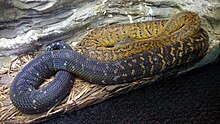Jamaican boa
| Jamaican boa | |
|---|---|

| |
| Scientific classification | |
| Kingdom: | Animalia |
| Phylum: | Chordata |
| Class: | Reptilia |
| Order: | Squamata |
| Suborder: | Serpentes |
| Family: | Boidae |
| Genus: | Chilabothrus |
| Species: | C. subflavus
|
| Binomial name | |
| Chilabothrus subflavus Stejneger, 1901[3]
| |
The Jamaican boa[4] or yellow snake[5] (Chilabothrus subflavus) (locally known as Nanka from the Asante dialect for snake: Onanka)[6] is a non-venomous boa species endemic to Jamaica. No subspecies are currently recognized.[4]
Description[]
The Jamaican boa is golden-green around the head and along the anterior section of the body, with black zigzag crossbars, becoming black toward the posterior end of its body. The snake's body is quite long, up to 2 metres (6 feet 7 inches) in total length.
Distribution and habitat[]
Found in Jamaica cockpit country, including Goat Island. The type locality given is "Jamaica".[3] Moist limestone forests.
Conservation status[]
This species is classified as Vulnerable (VU) on the IUCN Red List of Threatened Species with the following criteria: A2ce (v2.3, 1994).[7] A species is listed as such when the best available evidence indicates that a population decline of 20% is expected within the next ten years or three generations, whichever is the longer, due to a decline in the quality and area of occupancy. It is therefore considered to be facing a high risk of extinction in the wild. Year assessed: 1996.[8]
Their natural habitat is being destroyed, which is forcing them into inhabited areas, where they are captured and killed. Some measures have been taken to afford these animals some protection:
- Listed as a Protected species under the Wild Life protection Act (1945).
- Listed on Appendix I of CITES.
- Hunting in Forest reserves is also prohibited under the Forest Act (1996).
References[]
- ^ Gibson, R.; Hedges, S.B.; Wilson, B.S. (2021). "Chilabothrus subflavus". IUCN Red List of Threatened Species. 2021: e.T7826A18979286. doi:10.2305/IUCN.UK.2021-2.RLTS.T7826A18979286.en. Retrieved 18 November 2021.
- ^ "Appendices | CITES". cites.org. Retrieved 2022-01-14.
- ^ a b McDiarmid RW, Campbell JA, Touré T. 1999. Snake Species of the World: A Taxonomic and Geographic Reference, vol. 1. Herpetologists' League. 511 pp. ISBN 1-893777-00-6 (series). ISBN 1-893777-01-4 (volume).
- ^ a b "Chilabothrus subflavus". Integrated Taxonomic Information System. Retrieved 7 July 2008.
- ^ Jamaican Boa Archived 2009-08-08 at the Wayback Machine at www.nrca.org. Accessed 3 March 2009.
- ^ "Jamaican boa a protected species". 6 May 2010.
- ^ Epicrates subflavus at the IUCN Red List. Accessed 7 July 2008.
- ^ 1994 Categories & Criteria (version 2.3) at the IUCN Red List. Accessed 7 July 2008.
Further reading[]
- Stejneger, L. 1901. A New Systematic Name for the Yellow Boa of Jamaica. Proc. U.S. National Museum 23: 469–470.
External links[]
| Wikimedia Commons has media related to Epicrates subflavus. |
- Video - Yellow Boa at Windsor Cave (2014) - Jamaican Caves Organisation - 408 MB mp4.
- Epicrates subflavus at the Reptarium.cz Reptile Database. Accessed 7 July 2008.
- IUCN Red List vulnerable species
- Chilabothrus
- Snakes of the Caribbean
- Endemic fauna of Jamaica
- Reptiles of Jamaica
- Reptiles described in 1901
- Alethinophidia stubs
